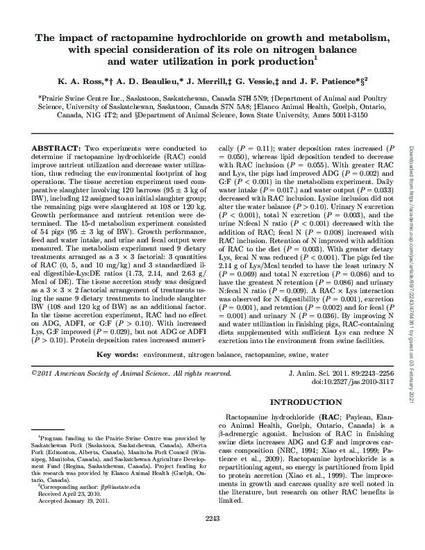
Two experiments were conducted to determine if ractopamine hydrochloride (RAC) could improve nutrient utilization and decrease water utilization, thus reducing the environmental footprint of hog operations. The tissue accretion experiment used comparative slaughter involving 120 barrows (95 ± 3 kg of BW), including 12 assigned to an initial slaughter group; the remaining pigs were slaughtered at 108 or 120 kg. Growth performance and nutrient retention were determined. The 15-d metabolism experiment consisted of 54 pigs (95 ± 3 kg of BW). Growth performance, feed and water intake, and urine and fecal output were measured. The metabolism experiment used 9 dietary treatments arranged as a 3 × 3 factorial: 3 quantities of RAC (0, 5, and 10 mg/kg) and 3 standardized ileal digestible-Lys:DE ratios (1.73, 2.14, and 2.63 g/Mcal of DE). The tissue accretion study was designed as a 3 × 3 × 2 factorial arrangement of treatments using the same 9 dietary treatments to include slaughter BW (108 and 120 kg of BW) as an additional factor. In the tissue accretion experiment, RAC had no effect on ADG, ADFI, or G:F (P > 0.10). With increased Lys, G:F improved (P = 0.029), but not ADG or ADFI (P > 0.10). Protein deposition rates increased numerically (P = 0.11); water deposition rates increased (P = 0.050), whereas lipid deposition tended to decrease with RAC inclusion (P = 0.055). With greater RAC and Lys, the pigs had improved ADG (P = 0.002) and G:F (P < 0.001) in the metabolism experiment. Daily water intake (P = 0.017.) and water output (P = 0.033) decreased with RAC inclusion. Lysine inclusion did not alter the water balance (P > 0.10). Urinary N excretion (P < 0.001), total N excretion (P = 0.003), and the urine N:fecal N ratio (P < 0.001) decreased with the addition of RAC; fecal N (P = 0.008) increased with RAC inclusion. Retention of N improved with addition of RAC to the diet (P = 0.003). With greater dietary Lys, fecal N was reduced (P < 0.001). The pigs fed the 2.14 g of Lys/Mcal tended to have the least urinary N (P = 0.069) and total N excretion (P = 0.086) and to have the greatest N retention (P = 0.086) and urinary N:fecal N ratio (P = 0.009). A RAC × Lys interaction was observed for N digestibility (P = 0.001), excretion (P = 0.001), and retention (P = 0.002) and for fecal (P = 0.001) and urinary N (P = 0.036). By improving N and water utilization in finishing pigs, RAC-containing diets supplemented with sufficient Lys can reduce N excretion into the environment from swine facilities.
Available at: http://works.bepress.com/john-patience/106/

This article is published as Ross, K. A., A. D. Beaulieu, J. Merrill, G. Vessie, and J. F. Patience. "The impact of ractopamine hydrochloride on growth and metabolism, with special consideration of its role on nitrogen balance and water utilization in pork production." Journal of animal science 89, no. 7 (2011): 2243-2256. doi: 10.2527/jas.2010-3117.